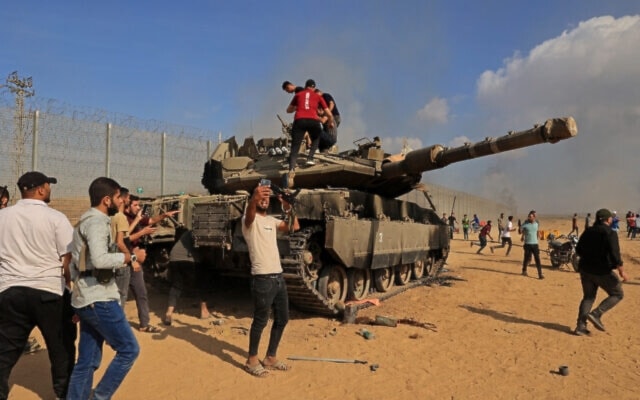New Oct.7 Israeli failure: Undermanned, out of position, unorganized
The IOF and Israeli security forces took hours before they understood the full extent of the operation.
-

Palestinians take control of an Israeli tank after crossing into the occupied Palestinian territory from Khan Younis in the southern Gaza Strip on October 7, 2023. (AFP)
Israeli occupation forces (IOF) lacked a structured response plan for a scenario similar to Operation Al-Aqsa Flood, as per an investigation released by The New York Times, quoting past and present soldiers and officers.
"As far as I recall, there was no such plan," said Yaakov Amidror, a retired Israeli general and former advisor to Prime Minister Benjamin Netanyahu, as quoted by NYT.
"The army does not prepare itself for things it thinks are impossible."
The investigation found that "Israel’s" military was "undermanned, out of position, and so poorly organized" that soldiers communicated in WhatsApp groups created on the spot and relied on social media posts for targeting information. Troops rushed into battle thinking that the combat would be brief so they were armed as such. Helicopter pilots were ordered to look for news reports and Telegram channels to choose targets.
Prior to the operation, Israeli intelligence officials thought that it was unlikely that Hamas would execute such an ambitious attack that they minimized the radio surveillance of Hamas, deeming it "a waste of time."
The true extent of the situation became evident in the weeks following October 7, having discovered that Hamas infiltrated the border into the occupied territories at 30 different points and rapidly advanced toward settlements along the Gaza border, it added.
Additional information from The New York Times investigation revealed that it took the IOF and Israeli security forces several hours to comprehend the full scale of the incident. Moreover, the IOF units positioned as the "initial line of defense" in the Gaza envelope settlements were not adequately trained for this scenario.
IOF unprepared, relying on WhatsApp and Telegram
The report revealed that Israeli forces were so disorganized that soldiers used WhatsApp groups and turned to social media for information. Helicopter pilots were instructed to depend on media reports and Telegram channels to identify the Resistance fighters.
In the Times investigation, it was revealed that Israeli commanders at the Kirya in "Tel Aviv", operating from a bunker called The Pit, were attempting to make sense of reports of Hamas rocket fire in southern "Israel".
Interviews with dozens of officers, soldiers, and eyewitnesses, many speaking anonymously, shed light on the disorganization. The initial deployed units were relatively small, suggesting a lack of understanding of the attack's magnitude. The first order for all emergency forces and available units to head south was issued at 7:43 am, prompted by a message from a base along the border reporting an attack, though the commander was unaware of the full extent of the operation.
The New York Times report asserted that certain IOF units in the occupied Palestinian territories just outside Gaza were inadequately trained, and military reservists were not ready for rapid mobilization and deployment. Furthermore, when the operation commenced, soldiers in the area were reportedly trying to save themselves rather than protecting settlers in their vicinity or coordinating a strategic response to the operation.
Soldiers were forced to abandon the "Nahal Oz" base, leaving behind their dead fellow soldiers. At "Kibbutz Re'im", housing the Gaza Division base, understaffing was reported. A soldier mentioned to the NYT that some were unaware of the attack until Resistance fighters entered their sleeping quarters.
'Where is the Israeli army?'
One reservist shared that his paratrooper unit departed its central base near "Tel Aviv" in a convoy around 1:30 pm. The mobilization was independent, lacking a formal call-up order.
He anticipated encountering crowded roads filled with soldiers, equipment, and armored vehicles heading south.
"The roads were empty!," he recounted in an interview, only to wonder roughly seven hours later: Where is the Israeli army?
It is worth noting that Israeli newspaper Haaretz published footage, on December 19, documenting the moment when an Israeli tank fired shells at a settler's housing unit in Kibbutz "Be'eri" in southern occupied Palestine on October 7.
In a related development, an IOF officer divulged, in an interview for The New York Times, that he had authorized a tank to launch two shells at a settler's housing unit in Kibbutz "Be’eri" on October 7. The housing unit had 14 Israeli settlers inside of it.
Twelve of the 14 Israeli settlers were killed in the Israeli shelling.
Read next: IOF officer admits authorizing tank fire on 'Be’eri' housing unit: NYT

 4 Min Read
4 Min Read








